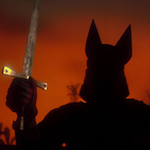 Francis Ford Coppola’s BRAM STOKER’S DRACULA is an incredible fucking movie that I previously mistook for a pretty good one. I saw it first on opening night in 1992, when I thought it was cool and weird, if flawed. (If you would like to imagine my wild teen years, I remember it was a foggy Friday the 13th and I was bummed that I hadn’t done anything good on Halloween, so I drove a carload of friends to an evening show, blasting the score from NIGHTBREED in the tape deck.)
Francis Ford Coppola’s BRAM STOKER’S DRACULA is an incredible fucking movie that I previously mistook for a pretty good one. I saw it first on opening night in 1992, when I thought it was cool and weird, if flawed. (If you would like to imagine my wild teen years, I remember it was a foggy Friday the 13th and I was bummed that I hadn’t done anything good on Halloween, so I drove a carload of friends to an evening show, blasting the score from NIGHTBREED in the tape deck.)
The second time was in 2000 after reading the book (Dracula by Bram Stoker, not Bram Stoker’s Dracula: The novel of the film by Fred Saberhagen and James V. Hart Based on the Screenplay by James V. Hart from the Bram Stoker novel, which I have not read and can’t afford). At that time I wrote about it along with a bunch of other Dracula movies, and you can see I was pretty hard on the “ridiculous origin story” and “trying to make him into a more sympathetic Dracula,” among other things.
But it felt overdue for a revisit and on this viewing all that stuff finally clicked for me. Though I always thought it was a stylish looking movie, I feel like I didn’t fully appreciate just how much, or how special that made it. And everything else worked better this time too.
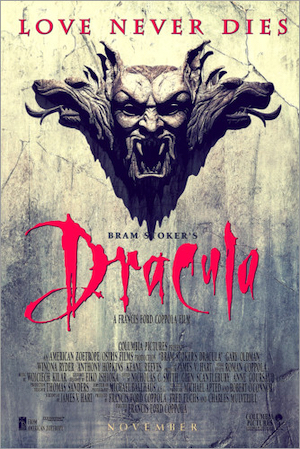 When I wrote about it last time I was real hung up on the idea that they present Dracula as if he’s supposed to be more of a tragic romantic figure than he is in most cinematic renditions, even sporting the long hair that signified historical hunkiness in the ‘90s. I was convinced that couldn’t work when he was played by Gary Oldman, because I knew he was brilliant playing over-the-top weirdos but I didn’t believe he could achieve anything above a Sid Vicious level of likability. Of course, since then the world has loved Oldman as Jim Gordon and as Harry Potter’s shop teacher or whatever, so that may have changed my view of him, but I also interpreted the intentions of the story differently this time. Yes, Vlad Dracula is presented as a fallen hero. When he returns from war, his wife Elisabeta (Winona Ryder, who brought Coppola the script while apologizing for backing out of GODFATHER III, and didn’t really expect him to read it) is dead,
When I wrote about it last time I was real hung up on the idea that they present Dracula as if he’s supposed to be more of a tragic romantic figure than he is in most cinematic renditions, even sporting the long hair that signified historical hunkiness in the ‘90s. I was convinced that couldn’t work when he was played by Gary Oldman, because I knew he was brilliant playing over-the-top weirdos but I didn’t believe he could achieve anything above a Sid Vicious level of likability. Of course, since then the world has loved Oldman as Jim Gordon and as Harry Potter’s shop teacher or whatever, so that may have changed my view of him, but I also interpreted the intentions of the story differently this time. Yes, Vlad Dracula is presented as a fallen hero. When he returns from war, his wife Elisabeta (Winona Ryder, who brought Coppola the script while apologizing for backing out of GODFATHER III, and didn’t really expect him to read it) is dead, having jumped having plummeted from a cliff after a false report of his death. When he’s told he won’t see her in Heaven because suicides don’t go to Heaven he knows that’s some fucked up shit for a church to say to a guy, especially a guy who just fought the fucking Crusades for them. So he impulsively blasphemes, stabs a cross, makes it bleed, drinks the blood, says some shit that curses him to eternal life and blood thirst. Honestly it’s some real drama queen shit whether or not he somehow knew living past his time would allow him to meet Elisabeta’s reincarnation.
But a thing I loved this time that I didn’t remember is that in that little prologue of his pre-vampire heroism he’s already a monster. We see his knightly derring-do in silhouettes that look like the shadow puppets that will later become a visual motif. Mr. Dreamboat here is just slaughtering Turkish soldiers left and right. He skewers one on a spear and hoists him in the air. The poor guy’s legs wiggle around like a stuck bug. Who would Jesus impale?
Yes, the filmmaking tells us Vlad is a great hero, but that’s what movies do. Sometimes movies, and history, are an unreliable narrator. For example if Mina and Jonathan live another 18 years after the events of this movie and visit America they could potentially see BIRTH OF A NATION and get some misconceptions about the place. Vlad can say he’s shishkebabing motherfuckers in the name of God’s righteousness – “God be praised. I am victorious” – but this is already more satanic than he’ll ever be in his years as a weird old creep living in a castle with three wives.
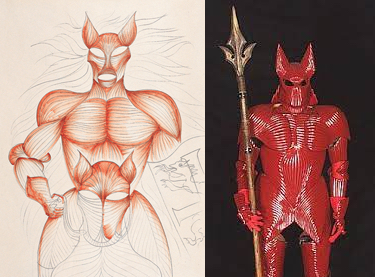 Of course, maybe he already has a sense of that, going to battle in red armor with a bat-head helmet and with grooves carved into it like muscle fiber. Although designer Eiko Sihioka (MISHIMA, THE CELL, THE FALL)’s costumes are all great, that armor might be the best thing to come out of Coppola’s edict to “Give me something that either comes from the research or that comes from your own nightmares.” Like all gothic horror movies this appeals to us with variations on the sort of images we expect to see (dark castles, coffins, full moons, fog), but touches like the armor and Dracula’s various looks combine that with a bit of a fantasy movie world-building feel. Enough that I wouldn’t mind seeing what other shit goes down in this place besides the timeless story of Dracula. Something where lots of different armor types are needed, hopefully.
Of course, maybe he already has a sense of that, going to battle in red armor with a bat-head helmet and with grooves carved into it like muscle fiber. Although designer Eiko Sihioka (MISHIMA, THE CELL, THE FALL)’s costumes are all great, that armor might be the best thing to come out of Coppola’s edict to “Give me something that either comes from the research or that comes from your own nightmares.” Like all gothic horror movies this appeals to us with variations on the sort of images we expect to see (dark castles, coffins, full moons, fog), but touches like the armor and Dracula’s various looks combine that with a bit of a fantasy movie world-building feel. Enough that I wouldn’t mind seeing what other shit goes down in this place besides the timeless story of Dracula. Something where lots of different armor types are needed, hopefully.
“May God reunite us in Heaven,” Dracula said back in those naive days. Uh, yeah… no. 435 years after the cross-blood incident he’s allowed himself to age into a decrepit old man with giant heart-shaped hair. He scoffs at crosses: “Do not put your faith in such trinkets of deceit.” For reasons I’m unclear on he’s trying to buy some property in London, so English real estate agent Jonathan Harker (Keanu Reeves, coming off a stellar run of POINT BREAK, BILL & TED’S BOGUS JOURNEY and MY OWN PRIVATE IDAHO) comes to the Count’s castle in Transylvania to make arrangements. Jonathan is taking over the account for his co-worker Renfield (Tom Waits, also in Coppola’s ONE FROM THE HEART, THE OUTSIDERS, RUMBLE FISH and THE COTTON CLUB), who had to bow out early due to being committed to an insane asylum, where he serves insect hors d’oeuvres and rants out the window about his master Dracula’s promised arrival. Weird. Oh well, I’m sure it’s nothing, this seems like a pretty good gig.
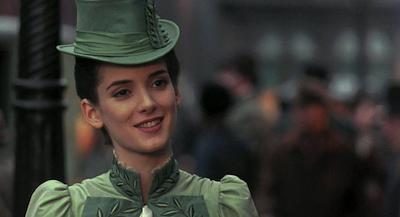 The casting of Reeves was one of the main criticisms people had of the movie, and probly still is. Whatever the vampire’s real estate plans are, it’s Jonathan who summons him to London by carrying a photo of his fiancee Mina (Winona Ryder, NIGHT ON EARTH), who is a dead ringer for Elisabeta. This inspires Dracula to have his minions pack him in dirt and put him on a ship where he’ll drain the whole crew and jump off in dog form upon arrival, drinking enough blood to reform as a young man with fancy top hat and round purple sunglasses and approach Mina as a confused Transylvanian tourist. Which, to be fair, many of us would’ve been willing to do for Winona back then.
The casting of Reeves was one of the main criticisms people had of the movie, and probly still is. Whatever the vampire’s real estate plans are, it’s Jonathan who summons him to London by carrying a photo of his fiancee Mina (Winona Ryder, NIGHT ON EARTH), who is a dead ringer for Elisabeta. This inspires Dracula to have his minions pack him in dirt and put him on a ship where he’ll drain the whole crew and jump off in dog form upon arrival, drinking enough blood to reform as a young man with fancy top hat and round purple sunglasses and approach Mina as a confused Transylvanian tourist. Which, to be fair, many of us would’ve been willing to do for Winona back then.
As Reeves would be the first to admit, he struggles with the accent, or with being accepted having the accent. Doesn’t bother me now. Today most of us have a fuller understanding of Keanu’s powers, and I definitely appreciate his performance more now than I did then. There’s a dark comedy to this friendly doofus sitting in that castle, seeing all that weird shit, still totally clueless about the deep shit he’s gotten himself into for work. I especially laughed at him looking out the window and seeing his host scurrying across the walls like a spider. I mean, what the fuck. Also uncomfortable: the shaky old Count insisting on shaving him. Even without the threat of the blade that’s just an awkward thing for your host to do.
Jonathan is also kind of like the gender-swapped version of the thankless girlfriend role in many male-dominated movies. It’s Mina’s story, he’s just the boyfriend, who gets the plot going and gets sexually victimized. It makes sense that you would get a hunky boy for that part, or as Coppola put it, “a matinee idol.” (They first offered it to Christian Slater, who I guess must’ve done KUFFS instead.)
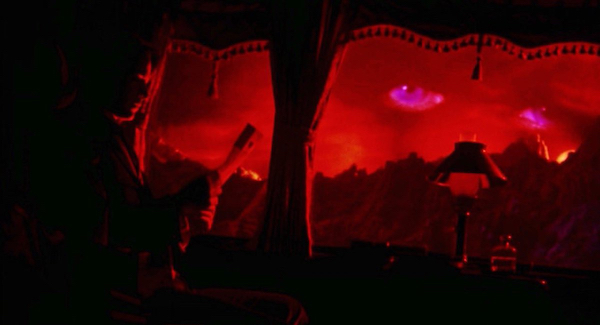
What slowly starts to dawn on Jonathan is that this is not only one of the most stunningly rendered gothic horror movies ever, it’s also kind of a sex movie. Back at home, repressed Mina is dealing with a burgeoning sexual curiosity, sneaking peeks at the Kama Sutra and jealously watching her more adventurous friend Lucy Westenra (Sadie Frost, THE KRAYS) juggle multiple suitors at a party. And on his business trip Jonathan tries to fend off Dracula’s three super hot wives (Monica Belluci, Michaela Bercu and Florina Kendrick) who attempt to suck his blood and/or menage him all over the place.
Sex is kind of scary though when you see it in the form of Dracula in wolf monster form biting/humping Lucy outside during a thunder storm. I mean, nobody wants to walk in on their friend having sex, but especially not like that. Some real POSSESSION shit.
So he turns young and approaches Mina in the daylight and she knows he’s hitting on her and rejects him at first. But she ends up showing him around in one of those romantic comedy deals where the lead meets an exciting person right before the wedding and questions everything. They even go to the movies together, although thankfully they don’t sit down or hold hands, they just walk around the building and talk. Mina is scared by a large white dog that Dracula then calms, much in the style of Riddick. I was hoping he would say something like, “It’s okay, he won’t bite. His name is Mr. Fluffers.” (I’m actually unclear if or how he knows this dog.)
Anthony Hopkins plays Dr. Van Helsing (and also the priest and narrator of the prologue, but nobody crosses oceans of time for him :( ) and I was surprised to realize that the Stephen Sommers VAN HELSING seems to have modeled his costume after this movie. Or the hat at least. I still like that this Van Helsing is uncomfortable to be around, which I thought on last viewing was faithful to the book.
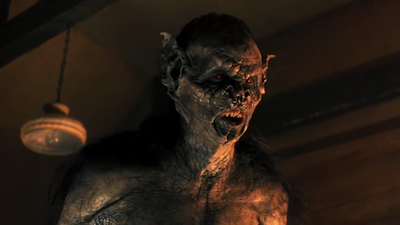 Even all those decades ago we horror fans could be cynical about the studios wanting to make prestige horror that would attract our money without sacrificing being all respectable like. But credit where credit is due: this one gets its claws dirty. Van Helsing hunts the three brides and casually carries their heads like bags of groceries. Dracula transforms into forms ranging from green fog to a bat monster to a pile of rats. The bat is particularly horrific – hats off to makeup genius Greg Cannom, who won his first Oscar for this (his most recent was in 2019 for creating a another great movie monster in VICE).
Even all those decades ago we horror fans could be cynical about the studios wanting to make prestige horror that would attract our money without sacrificing being all respectable like. But credit where credit is due: this one gets its claws dirty. Van Helsing hunts the three brides and casually carries their heads like bags of groceries. Dracula transforms into forms ranging from green fog to a bat monster to a pile of rats. The bat is particularly horrific – hats off to makeup genius Greg Cannom, who won his first Oscar for this (his most recent was in 2019 for creating a another great movie monster in VICE).
There’s also sort of an EXORCIST sequence where bedridden Lucy slowly turns lusty and vampiric while all the men in her life try to stop it; I’m happy to report that when Van Helsing later holds up across she pukes blood all over it and his face.
Also, you know, if you’re gonna do this scene why not give her a glass coffin and a white face and an extravagant dress with a giant collar and make it look weird and gorgeous?
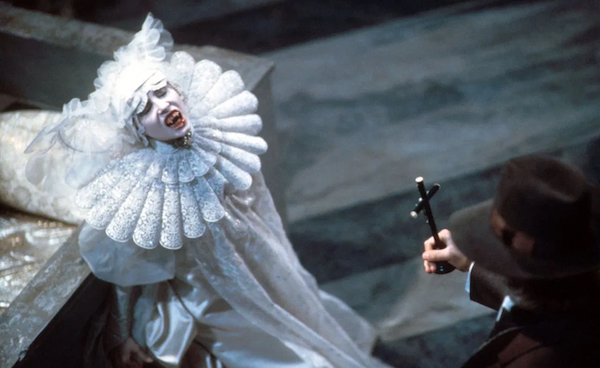
That’s the first thing you notice in the movie and the most lasting impression of it. It’s just so full of visual delight. With all the cool scene transitions – a dot on a peacock feather to a train tunnel, bite marks on a neck to glowing wolf eyes – it’s not surprising to read that Coppola had the entire movie storyboarded and turned into a leica reel to plan the shots. On the credits I noticed HELLBOY creator Mike Mignola and INTO THE SPIDER-VERSE director Pete Ramsey among the illustrators, and Nick Fury creator/Indiana Jones character designer Jim Steranko is “project conceptualist.” Mignola also illustrated a 4-issue comics adaptation of the movie, which makes a whole lot of sense.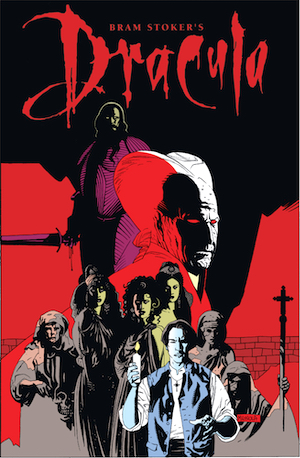
Coppola wanted it to be a tribute to early cinema, not just by having a major scene take place at an early cinema, but by basing the visual effects in classic in-camera, on-set techniques. When the visual effects team didn’t think what he wanted could be done without optical or digital effects he made his 27-year-old son Roman (associate producer, RUMBLEFISH) visual effects supervisor and second unit director.
That sounds like nepotism, but you can’t argue with the results. Using rear projection, multiple exposures, forced perspective and sets built at an angle they created all kinds of surreal and appealing imagery. When Dracula comes home from war to find that Elisabeta was told he died and committed suicide, her plummet is superimposed over the note she left. His thirst for blood is illustrated by seeing Mina’s circulatory system glow through her body. His eyes hover in the red sky outside a train window (over, I believe, a miniature model of mountains). An image of him fades in and out next to Mina when he can speak to her telepathically.
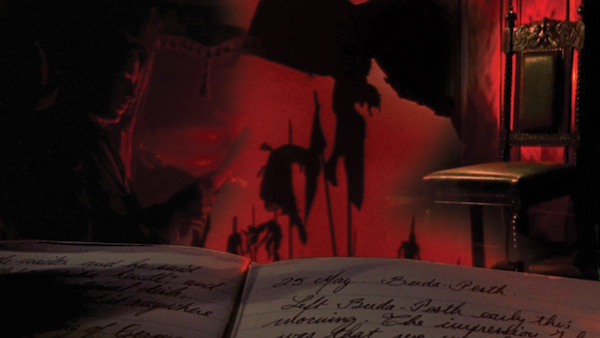
Some of the montage-based visual language, combined with the dark, booming score by Wojciech Kilar (THE PIANIST), put me in mind of Sam Raimi and ARMY OF DARKNESS, but of course they’re both drawing inspiration from the same antiquated styles. And that made me realize why Kenneth Branagh had the cameras flying around so much in MARY SHELLEY’S FRANKENSTEIN. He thought that was what he was how you get this feeling. He gave it his best.
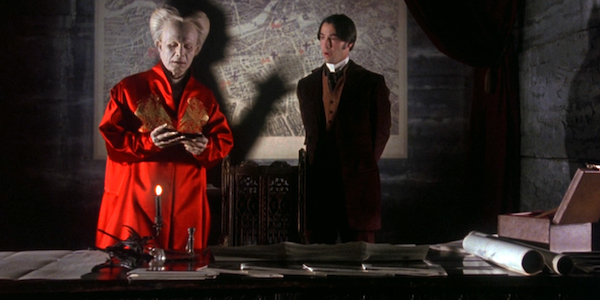 There’s a more authentically dream-like feeling to this thing than most movies ever manage to accomplish. The visual motif of shadows goes beyond the silhouettes and shadow puppets to Dracula’s shadow, which often moves independently of its host. (I don’t think it’s animation – there are a ton of puppeteers listed in the credits.) Often he moves as if floating just above the ground. In one scene his arm somehow reaches all the way across a room. My favorite gimmick shot is when a coachman (Dracula) reaches out with his monster-like armored hand and it seems to grow huge and reach 7 or 8 feet to lift Harker into the coach. It was accomplished with an in-camera forced perspective trick that I saw explained but still don’t understand.
There’s a more authentically dream-like feeling to this thing than most movies ever manage to accomplish. The visual motif of shadows goes beyond the silhouettes and shadow puppets to Dracula’s shadow, which often moves independently of its host. (I don’t think it’s animation – there are a ton of puppeteers listed in the credits.) Often he moves as if floating just above the ground. In one scene his arm somehow reaches all the way across a room. My favorite gimmick shot is when a coachman (Dracula) reaches out with his monster-like armored hand and it seems to grow huge and reach 7 or 8 feet to lift Harker into the coach. It was accomplished with an in-camera forced perspective trick that I saw explained but still don’t understand.
With all these giant sets, period and/or artistic costumes, elaborate special effects makeup and clever visual invetion this is the kind of production the word “lavish” could’ve been invented to describe. That means it doesn’t have to follow the majority of Dracula movies (which had lower budgets and/or were adapted from stage versions) in confining the story to a few locations. Instead it follows the book in turning into an international adventure when partially-turned Mina uses her telepathic connection to Dracula as a tracker to help the boys chase him down. I didn’t really follow why they seemed to be able to use the sunlight against him (it was previously established that that’s not a thing), but it’s an exciting battle, and I love that when Mina stops them from finishing him off they are cool enough to let her take him into the very chapel where he drank that blood from that cross and put him out of his misery.
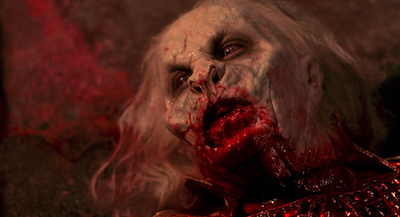 This time I did actually feel sad for Dracula, and I was glad he got peace. I mean yes, true, he sucks, fuck that guy, but also I’m happy for him finding closure. The whole movie is so god damn operatic, I gotta accept the big emotions that maybe don’t translate exactly to my daily life. So there’s something beautiful about this fucker in his pathetic penultimate form, the withered old man combined with the bat monster, laying helplessly on the ground wheezing, crying, his maw smeared with viscera, the amazement visible in his eyes when Mina still calls him “my love.” When, like Anakin Skywalker, he’s mercifully returned to his young, un-fucked-up form, he asks her to “give me peace” with a violent thrust of a fancy sword.
This time I did actually feel sad for Dracula, and I was glad he got peace. I mean yes, true, he sucks, fuck that guy, but also I’m happy for him finding closure. The whole movie is so god damn operatic, I gotta accept the big emotions that maybe don’t translate exactly to my daily life. So there’s something beautiful about this fucker in his pathetic penultimate form, the withered old man combined with the bat monster, laying helplessly on the ground wheezing, crying, his maw smeared with viscera, the amazement visible in his eyes when Mina still calls him “my love.” When, like Anakin Skywalker, he’s mercifully returned to his young, un-fucked-up form, he asks her to “give me peace” with a violent thrust of a fancy sword.
But also, because beautiful isn’t always enough, the angelic choir celebrating his soul’s redemption is accompanied by the loud metal clang of Mina yanking the sword from his chest and whacking his fuckin head off. I love it.
In trying to make a movie like they used to, Coppola made a movie unlike anybody ever had, or has since. You can put the author’s name in the title but it ain’t gonna make it this. Man, I enjoyed this movie at the time, but I didn’t really get it. That’s a nice thing about getting older as a movie lover – revisiting films you first saw when you were different, and the world was different, and movies were different, and getting to see them in a different way. Crossing oceans of time to fall in love with a movie.


























November 10th, 2021 at 12:24 pm
This and JURASSIC PARK was to me most likely what STAR WARS was like to that generation. That is to say this movie blew my damned mind when I finally saw it as a youngling. Like how was what this thing showed us even possible? Still a huge favorite and equal to the Legosi one for me as well.
Shame Coppola doesn’t seem to think much of it according to the audio commentary, at least twice he makes sure we know this was done solely for the paycheck. Much better than JACK in my opinion (the only one of his ’90s movies I can find evidence of him defending(!).